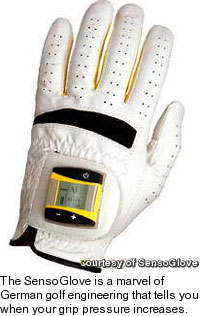 EQUIPMENT REVIEW
EQUIPMENT REVIEW
Get a grip! SensoGlove monitors golfers' grip pressure
By Kiel Christianson,
Senior Writer
Several years ago, I was on a golf outing early in the season with a bunch of friends. At the end of the first 36-hole day, my left forearm was aching so badly I could hardly move my hand.
"You're strangling your golf club," said one of the doctors in the group. "Don't squeeze so tight." Then he gave me an icy cold beer can to hold on my forearm (and another one to drink).
The funny thing was, I didn't notice while playing that my grip had been so tight. It was completely subconscious.
|
The SensoGlove ($119), a new training aid from Germany, aims to help golfers pay more attention to their grip pressure and, according to the company, gain better control over their swing.
The idea is simple: Most golf instructors advise their students to grip the club just tightly enough to keep it from flying out of their hands. Any tighter, they say, and you lose clubhead speed and control over the ball.
Most of us, however, tend to apply uneven grip pressure, tightening up on the backswing or downswing, or somewhere else in the swing. This is especially true in the short game, where sudden changes in grip pressure result in the "full-body hiccup" thing that causes so many chunked, flubbed and skulled chips.
How the SensoGlove works
If the idea behind the SensoGlove is simple, the implementation is complex. Leave it to the genius of German engineers to develop such an elegant device.
The SensoGlove is an actual golf glove with sensors sewn into the fingers and a microcomputer and LCD screen embedded in the back. To use the glove, you put it on and switch on the computer while not holding anything. Then you grip the club with about 50 percent of your normal grip pressure, thereby setting the sensitivity, and you're ready to swing. If your grip increases during your swing, the glove beeps, and on the LCD, you'll see a diagram of your hand, showing you which fingers increased their pressure.
According to the company, the sensitivity of the sensors in the last two fingers is set to a higher threshold, as that's where you are in fact supposed to grip the club more tightly. Those Germans are so clever!
The verdict on SensoGlove
Although I read the instructions in both English and German (my second language), I had trouble setting the proper grip pressure at first. As a result, the SensoGlove beeped relentlessly during my swing.
After a quick tutorial from the company, I got it to work just fine and was rewarded with a beep-free swing - well, almost beep-free. The SensoGlove let me know that my grip pressure increases from my optimal "6" reading only on my follow-through, well after the ball is in the air. As far as I know, this isn't a problem.
Actually, the one lingering concern I have about the SensoGlove is what the grip pressure reading actually means; the readings range from "1" (extremely tight) to "18" (extremely loose).
One of the people at the company told me that a European Tour pro he met on the practice range had a grip pressure of "9." So, it would appear that my "6" could be loosened, though I would assume that one's optimal grip pressure would be a very idiosyncratic thing. So, the SensoGlove can't really tell you the best pressure for you, just what your pressure is and when it increases.
Perhaps with some more work, however, I can just drink two cans of beer, instead of applying one of them to my forearm.
For more information, visit www.SensoGlove.com.
December 2, 2008
Any opinions expressed above are those of the writer and do not necessarily represent the views of the management.